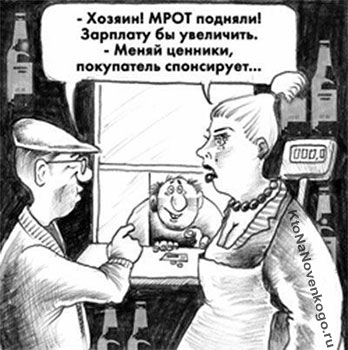A social state implies some more or less fair relationship between the administration and citizens in the financial sphere. Therefore, it is necessary to somehow establish reasonable amounts of fines and social benefits, payments to pensioners and wages to workers.
In order to prevent excessive distortions and ensure a level of justice sufficient for the stability of society, various coefficients and parameters are introduced when calculating the financial component of the mentioned social relationships at the state level.
One of the most frequently used and significant parameters for society is the so-called minimum wage. This is the indicator we will talk about today.
Minimum wage: what is it?
The abbreviation MROT stands for minimum wage. This is the lower threshold of the amount that an employer is required to pay an employee for a full month worked. This indicator is approved by law and is mandatory for all employers, regardless of the form of ownership of the organization. Failure to fulfill the employer's obligation to set a salary not lower than the minimum wage entails administrative liability.
For almost the entire post-Soviet history, Russia was characterized by a significant lag between the minimum wage and the subsistence level, and only since 2016 the situation began to change. From May 1, 2018, the minimum wage is equal to the average subsistence level in the country.
Changes in the federal minimum wage in the Russian Federation over the past 10 years
Data are presented in reverse order.
| Date of establishment of the new minimum wage | Minimum wage amount |
| from January 1, 2021 to the current moment | 12130 rubles |
| from January 1, 2021 to December 31, 2019 | 11280 rubles |
| from May 1, 2021 to December 31, 2018 | 11163 rubles |
| from January 1, 2021 | 9489 rubles |
| from July 1, 2021 | 7800 rubles |
| from July 1, 2021 | 7500 rubles |
| from January 1, 2021 | 6204 rubles |
| from January 1, 2015 | 5965 rubles |
| from January 1, 2014 | 5554 rubles |
| from January 1, 2013 | 5205 rubles |
| from June 1, 2011 | 4611 rubles |
| from January 1, 2009 | 4330 rubles |
Watch a foreign video, designed in a cartoon format with Russian subtitles, which clearly reveals the essence of the concept of minimum wage (minimum wage) and how it affects unemployment:
Video: How the minimum wage creates unemployment
What it is? Decoding the concept
What is the minimum wage
The following factors depend on this indicator:
- additional charges;
- taxes;
- fines.
What does the phrase “minimum wage” mean? This denotes a certain minimum established at the legislative level. Any manager must pay this minimum amount to his subordinates for a full month worked. The threshold is set to ensure minimum guarantees for any citizen.
Paying less than the minimum wage is a serious violation of current laws. The salary must be equal to or exceed the minimum. Violations will bring the manager to administrative or criminal liability.
The minimum wage is needed, first of all, to regulate wages in the state. This characteristic is required for:
- Assessments of the rights of insured citizens regarding pension contributions.
- Determination of the amount of social benefits.
- Determining the amount of insurance payments in the case of entrepreneurs or persons engaged in private legal practice.
- Calculations of prices for goods and services.
- Definitions of taxes with penalties.
Why and who needs a minimum wage?
First of all, the minimum wage is used to regulate labor relations. Employers of any form of ownership do not have the right to pay wages below the minimum level established by law. Exceptions are specifically stated in the law; they will be discussed below.
In addition, social benefits (maternity benefits, sick leave), and in some cases unemployment benefits are calculated based on the minimum wage.

The size of the minimum wage in the Russian Federation has not only economic, but also political significance. Some political forces have long called for an increase in the minimum wage to a living wage. Others argued that such actions would fuel inflation by causing wage increases that were not matched by increases in labor productivity and, as a consequence, higher prices. As a result, the principle of political expediency prevailed: against the background of a series of election campaigns over 2 years, the amount of the minimum wage increased by more than 80%. A mitigating circumstance was the record low level of inflation in the country.
In total, according to the Ministry of Finance of the Russian Federation, an increase in the minimum wage directly affects payments to approximately four million working residents of the country. Another 12 million have salaries and benefits tied to the minimum wage.
What is it and what is it used for
Minimum wage in simple words is the minimum wage that an employer is obliged to pay to an employee. An employee who has fully worked a calendar month and fulfilled his or her job duties should not receive less than the established amount.
You can give me many examples where this is not the case and the employee receives less than the approved level. In most cases, this is not against the law. I'll explain why next. And if a violation is nevertheless committed, sanctions will be applied to the employer. We’ll also talk about them separately.
To understand whether your boss is complying with the requirements of the law or not, you need to clarify two points:
- Wages are monetary remuneration for work plus compensation (for example, for working in hazardous conditions) and incentive (bonuses) payments.
- Salary is a fixed amount of wages per month without taking into account any payments.
Thus, your salary may be less than the established minimum wage. Controlling authorities check wages with additional payments. So it cannot fall below the minimum value.

After reading, you will understand how to stop working for pennies at a job you don’t like and start LIVING truly freely and with pleasure!
And one more nuance. The calculations include the so-called “dirty” salary, i.e. before payment of income tax (13%). Therefore, in reality, the employee may well receive an amount below the minimum wage. This is not against the law.
It will also not be a violation if an employee receives wages less than what is required by law, but at the same time works part-time, part-time, or just a couple of days a week.
The minimum wage is not only an economic, but also a political instrument. When, on the eve of the elections, we are told that the minimum wage will now be equal to the subsistence level, many rejoice. But the majority of the population will not be affected by the minimum wage established by the state at all.
What does the minimum wage affect in this case? After all, what is it installed for? This indicator is used to calculate social benefits for:
- sick leave,
- pregnancy and childbirth,
- child care up to 1.5 years old,
- other social benefits.
Let me clarify that the indicator will be applied only if the employee has no work experience at all, or it is less than 6 months. For other categories, the average salary is included in the calculations, not the minimum.
It turns out that the minimum wage concerns exclusively workers who receive small salaries. If you have it, for example, 25 thousand rubles, then this figure should not worry you.
Who sets the minimum wage
The minimum wage according to Russian legislation is established both at the level of the entire country and for each region. Moreover, the regional minimum wage cannot be less than the federal one.
The all-Russian level is proposed by the government of the Russian Federation, adopted in the form of a law by the State Duma, approved by the Federation Council and signed by the president. The regional size of the minimum wage is established by an agreement concluded for 3 years between the government of the region, territory or republic, the regional association of trade unions and the regional association of industrialists and entrepreneurs.
Calculation of the minimum wage and some application features
At the federal level, a decision is made on what level of minimum wage will be in effect in the country in the near future. Regional authorities have the right to increase the minimum amounts.
But, in any case, the payment cannot be less than the level established by the state. Employers pay their subordinates exactly the salary that corresponds to the regional minimum wage level.
The amount is subject to constant adjustments depending on the current inflation rate. Sources for financing the minimum are described in the Labor Code, in article 133.
The employer's own funds in this case become the main source of payments. If we are talking about budgetary enterprises, then they are financed by higher authorities at the appropriate level.
The Federal Assembly of the Russian Federation sets the federal minimum wage level. The corresponding accompanying document is signed by the President. As for specific subjects of the country, in this case a tripartite agreement is signed. It is approved when a compromise is reached with the participation of the following parties:
- Union of Industrialists and Entrepreneurs;
- trade union or other similar organizations acting on behalf of employees;
- government, regional administration.
Information about the minimum wage must be published in the media. Entrepreneurs can express their disagreement with the established sizes within 30 days after this event.
What laws regulate the minimum wage?
The minimum wage is regulated by several legal acts.
1 Federal Law “On the Minimum Wage” (No. 82-FZ of June 19, 2000).
A fairly outdated document, the main value of which is to determine the scope of the minimum wage: to regulate wages and determine the amount of benefits for temporary disability, pregnancy and childbirth, as well as for other purposes of compulsory social insurance. This indicator cannot be used for other purposes.
2 Article 133 of the Labor Code of the Russian Federation.
It states that the minimum wage cannot be lower than the subsistence level. This point has not been implemented for a long time, but since May 2021, reality has been brought into line with the law. Also, Article 133 specifies how the minimum wage should be paid:
- private companies - at their own expense;
- budgetary companies - at the expense of funds from the relevant budgets (federal, regional or local, depending on the organization’s jurisdiction) and extra-budgetary money (for example, from income from paid services, voluntary donations, grants, etc.).
In addition, it is noted that the minimum wage is due to any employee who has fulfilled the monthly work standard established for his position.
3 Article 133.1 of the Labor Code of the Russian Federation
It regulates the setting of minimum wages in the regions. The text almost completely repeats Article 133 with the difference that in regions, territories and republics, workers’ wages cannot be lower than the regional minimum wage. The regional minimum wage does not apply to employees of organizations financed from the federal treasury.
4 Article 129 of the Labor Code of the Russian Federation
Here it is defined that wages are salary, compensation and incentive payments. In relation to the minimum wage, this formulation is important because theoretically, an employee’s salary may be less than the minimum if he does not fulfill the requirements that entail receiving a bonus. This is in conflict with Article 133 of the Labor Code of the Russian Federation (“The monthly wage of an employee who has fully worked the standard working hours during this period and fulfilled labor standards (labor duties) cannot be lower than the minimum wage”). A way out of such a legal conflict was found in increasing the compensation part: even if an employee is not entitled to a bonus in a given month for some reason, he is given an additional payment up to the minimum wage level.

5 Resolution of the Constitutional Court of the Russian Federation dated December 7, 2017 N 38-P
A document with the dry title “On the case of verifying the constitutionality of the provisions of Article 129, parts one and three of Article 133, parts one, two, three, four and eleven of Article 133.1 of the Labor Code of the Russian Federation” is extremely important for millions of Russians. In it, the Constitutional Court of the Russian Federation put an end to discussions of whether regional coefficients (RC) are included in the minimum wage. The fact is that in Article 129 of the Labor Code of the Russian Federation until 2007 there was a clause that the minimum wage is the minimum wage for unskilled labor under normal conditions (accordingly, any allowances for qualifications and special conditions must go above the “minimum wage”). There are still many articles circulating on the Internet that cite this point as valid. However, back in April 2007, State Duma deputies excluded it from the law. They did not fail to take advantage of this in regions where increasing coefficients were established for difficult working conditions - in the Far North, for example.
As a result, it turned out that the region set the minimum wage slightly higher than the federal one, but allowed “northern” allowances to be included in it. The Constitutional Court explained that the minimum wage must be provided to all workers, regardless of working conditions. This means that the “northerns” have nothing to do with it. Accordingly, employers are obliged to pay employees not “minimum wages, including the Republic of Kazakhstan”, but “minimum wages plus the Republic of Kazakhstan”.
6 Federal laws No. 41-FZ of March 7, 2018 and No. 421-FZ of December 28, 2017.
These legal acts establish the amount of the minimum wage as of May 1, 2021 and the rules for changing the minimum wage subsequently (more on this in the FAQ section).
Legal aspects
The Federal Law “On the Minimum Wage” was adopted on June 19, 2000. The legislative acts stipulated that from July 1 the minimum wage was 132 rubles, from January 1, 2001 - two hundred rubles, and in 2021 - 7,800 rubles. Compliance with the legal minimum is monitored by higher authorities:
- prosecutor's office;
- tax office;
- Labour Inspectorate;
- social insurance fund.

If a violation is detected, a system of fines is applied to the employer. Their structure and sequence of action are registered in the Administrative Code of the Russian Federation. The manager of the company or the enterprise itself are subject to sanctions. The organization and director are fined, and entrepreneurs are forced to make payments or cease activities for a certain period.
What is included in the minimum wage
Based on the above legal acts, the minimum wage includes:
- An official salary or other remuneration for work based on the employee’s skill level.
- Compensatory payments (in particular, additional payment to the minimum wage level for employees whose salaries are lower, as well as a regional coefficient in territories where they are in no hurry to implement the decision of the Constitutional Court of the Russian Federation, given above).
- Premium payments.
How is the indicator determined?
The decree on the minimum wage (minimum wage) is adopted at the government level. Regional authorities have the right to decide to increase the amount of minimum payments, but it cannot be less than what is already established.
Minimum wages are periodically adjusted depending on the increase in the general price index for goods and services. The minimum wage by year should ideally not be lower than the minimum income level in the region for the working population.
The main reserve is the own funds of a private enterprise. For government agencies, the source of income is the budget of a certain level (federal, local).

The national minimum wage is established by the Parliament of the Russian Federation (which is a representative and legislative body), signed by the president, and this document receives the force of a federal legislative act. In the regions, the minimum wage is determined by a tripartite agreement. It is developed based on a general solution, and then approved:
- the highest executive collegial body of government or regional administration;
- trade union or other association from employees;
- All-Russian public organization representing the interests of business circles.
After the agreement is announced in the regional media, employers have the right to express their negative assessment by writing a written statement to the regional administration.
If during a certain period the enterprise does not express its opinion on this issue, then this is regarded as acceptance of the situation. In reality, such cases rarely occur.

Minimum wage when working on weekends and holidays
The Labor Code includes special articles devoted to work on holidays, weekends, and at night. This time is calculated and paid in excess of the labor standards established for this position. Accordingly, overtime is not included in the minimum wage. Payments for additional time worked are not included in the minimum wage (if a junior teacher works at one and a half times the rate, the “minimum wage” is calculated based on one rate).
For overtime hours, payment is 1.5-2 times more expensive than usual (Article 152 of the Labor Code of the Russian Federation), and for work on holidays or weekends - double the amount of payment. Night work is paid in accordance with the standards at each enterprise, but always at an increased rate (by at least 20%) compared to daytime work. The difference is also not taken into account in the minimum wage.
How is the minimum wage calculated?
The minimum wage is determined by the government of the state based on the current economic situation in the country.
- When inflation rises, to prevent the emergence of social tension, the minimum wage is increased in accordance with the depreciation of the national currency.
- When the currency strengthens, wages rise again.
- It is clear that with the growth of the total gross product and during periods of economic growth of the country, the minimum wage increases accordingly.
- The minimum wage set by the government is mandatory throughout the country.
This is interesting: TOP 6 services for making money on Likes in social networks
Local authorities have the right to adjust the actual values of this parameter in accordance with local conditions. But only upward. Since reducing the coefficient would be a violation of federal laws.
Can wages be lower than the minimum wage?
The minimum payment is based on a full monthly rate. For part-time employees, the organization has the right to pay them a salary less than the minimum.
Similarly, an enterprise lowers wages if work is carried out part-time, part-time, part-time, or part-month.
The ratio of minimum wage and salary
If the employee’s salary includes only the salary, and the variable part is not provided, then the salary must be no less than the minimum wage. But when the salary includes bonuses, allowances and other incentive components, the salary may be lower than the minimum wage. As mentioned above, Article 133 of the Labor Code of the Russian Federation only requires that the total amount of remuneration for work not be lower than the minimum wage.
An important question: what amount is considered the minimum amount - including personal income tax or “net”, received by the employee in person? The legislation views this issue as follows: the employer is an intermediary between the employee and the tax service. It is not he who collects the tax. This means that the employer’s task is to charge an amount no less than the minimum wage. And paying income tax on this money is the employee’s business; the employer has nothing to do with him (except for technical transfers). Accordingly, from May 1, 2021, the employer is obliged to charge an amount not less than 11,163 rubles. In fact, taking into account the payment of personal income tax, the employee receives 9,711.8 rubles.
Here are two more cases when wages can be legally lower than the minimum wage:
1Part-time job. Article 285 of the Labor Code of the Russian Federation provides for remuneration for part-time work based on the volume of output or in proportion to the time worked.
2Part-time work. Article 93 of the Labor Code of the Russian Federation allows the employer to pay below the minimum wage for part-time work. This can be either ordinary work in a reduced volume, or the activities of certain categories of workers who are allowed by the Labor Code to use part-time work (minors; pregnant women; caring for sick family members; parents of a disabled child under the age of 14).

What are the consequences of a salary below the minimum wage?
Despite the fact that remuneration for a full month of any work cannot be lower than the minimum wage, there are quite a lot of organizations in Russia where even the minimum wage is not paid. Due to the peculiarities of tax legislation, the main reason for violating the requirements of the Labor Code is an attempt to reduce the fiscal burden on business. The lower the salary, the less accrual on it (amounts going to the Pension Fund and Social Security Fund). Therefore, many entrepreneurs prefer to pay a meager salary officially, and the rest of the salary goes “in an envelope” and is not subject to state accounting and taxation. In many cases, it turns out that formally the monthly payment is below the minimum wage.
For employers paying wages below the minimum established level, a fine of 10 to 20 thousand rubles is provided for officials, and from 30 to 50 thousand rubles for legal entities. Individual entrepreneurs can be punished with a fine of 1,000 to 5,000 rubles.
For a repeated violation, the fine for officials increases to 20-30 thousand rubles, for legal entities - up to 50-100 thousand, for individual entrepreneurs - up to 10-30 thousand rubles. In this case, the guilty official (for example, the director of a company) may be disqualified for up to three years.
What to do if your salary is below the minimum wage?
If you really want to officially receive at least the minimum level of wages (this is not always rational for the employee, since by increasing the official part of the salary, the employer reduces the total amount paid, subtracting taxes and charges from it), the procedure is as follows:
1Make a free-form demand to the employer to review your salary and pay the difference between your official salary and the minimum wage for the entire period of work.
2If the employer refuses to revise the official part of the salary, a copy of the request along with the application can be sent to the labor inspectorate or the prosecutor's office.
Minimum wage and living wage
Article 133 of the Labor Code of the Russian Federation directly states: the minimum wage should not be lower than the subsistence level. Since the beginning of the 90s, this standard has not been met due to a lack of budgetary funds (most of the positions that are paid below the minimum are in the public sector). Since 2021, the gap between the minimum wage and the living wage has begun to narrow. And on both sides: in many regions, decisions were made to reduce the cost of living.
In order to avoid such manipulations and due to the low level of inflation, as well as for the political reasons that have already been mentioned, a decision was made from May 1, 2021 to set the minimum wage at the level of the average subsistence level in the country. However, in reality, due to the collection of personal income tax, the income of an employee receiving the minimum wage will still be below the subsistence level.
Pros and cons of increasing the minimum wage
The positive aspects of increasing the minimum wage are obvious: rising wages improve the standard of living of the population.
The negative aspects are well disguised. Let's analyze the disadvantages of increasing the minimum wage:
- not all employers are able to pay their employees wages increased to the minimum wage. This leads to job losses and increased unemployment;
- a decrease in the difference between the average salary and the minimum wage reduces the motivation of low-wage workers to acquire new skills and knowledge;
- reduction of investments in economically weak regions. It becomes less profitable for investors to invest their funds due to the fact that they will have to pay more to hired workers. This leads to an outflow of investment to countries with lower labor costs;
- an increase in prices for manufactured goods, since the calculation of the selling price includes wages of workers.

Read our useful articles and you will always be up to date with all the news!
See you on the pages of our blog! Good luck to you! See you soon on the blog pages KtoNaNovenkogo.ru
Minimum wage and sick leave
Temporary disability benefits are calculated based on the minimum wage in several cases:
- If the employee's work experience is less than 6 months.
- When the average employee's earnings are below the minimum wage.
- If the sick person has had no income in the last 2 years.
- If an employee, being admitted to a hospital, violated the hospital regime (for example, went home without permission, interrupting the course of treatment).
- If an employee missed a regular medical examination (at jobs where it is mandatory) and then went on sick leave.
The amount of sick pay depends on length of service. The calculation algorithm is as follows:
1Calculation of the minimum average daily earnings (MSW):
MSZ = minimum wage * 24 months / 730 days
2If sick leave has been issued over the past two years, then the number of days of temporary disability is subtracted from 730 days.
Minimum wage and benefits
“Maternity” benefits are calculated based on the minimum wage in several cases:
- If the employee has not worked within the last 2 years
- If the employee’s average salary was lower than the current minimum wage
- If the employee's length of service is less than six months
Child care benefits up to 1.5 years old cannot be lower than the minimum wage.
Unemployment benefits depend on the minimum wage when the unemployed person has minor children or other persons with limited legal capacity as dependents. In this case, the benefit amount increases by ½ minimum wage for each dependent.
The maximum unemployment benefit cannot exceed the “minimum wage” by more than 1.5 times.
Payments that no longer depend on the minimum wage
Until recently, entrepreneurs made insurance contributions based on the minimum wage, but from January 1, 2021, they were replaced by fixed amounts.
Until mid-2007 (before amendments were made to the Code of Administrative Offenses by Federal Law No. 116-FZ dated June 22, 2007), fines depended on the minimum wage. The minimum wage for calculating fines was considered equal to 100 rubles.
Until July 2009, the minimum wage was used to calculate the size of the authorized capital of joint-stock and unitary enterprises.

Minimum wages in the regions
In accordance with Article 133 of the Labor Code of the Russian Federation, any region of Russia has the right to establish its own minimum wage. The only condition is that it should not be lower than the federal one. In the northern regions, in addition to the national minimum wage level, bonuses and coefficients are awarded. In Moscow and St. Petersburg, the minimum wage has historically been higher than the national average. The minimum level of wages varied significantly in cities with special working conditions (Norilsk and other industrial areas). Before May 1, 2018, almost three dozen regions of the country had a minimum wage that differed from the national minimum wage. After raising the minimum level to 11,163 rubles, the number of such federal subjects decreased.
Regions in which the minimum wage differs from the national average
| Region | Regional minimum wage (rub.) |
| Moscow | 18742 |
| Saint Petersburg | 17,000 (11,163 for public sector employees) |
| Magadan Region | 19500 – 21060 (depending on territory) |
| Kamchatka Krai | 18360 – 21180 (depending on territory) |
| Irkutsk region | 11163 – 27908 (depending on territory) |
| Krasnoyarsk region | 11163 – 26376 (depending on territory) |
| The Republic of Sakha (Yakutia) | 17388 (11163 – for public sector employees) |
| Yamalo-Nenets Autonomous Okrug | 16299 (including allowances and bonuses) |
| Murmansk region | 15185 (11163 – for public sector employees) |
| Moscow region | 13750 (11163 – for public sector employees) |
| Tula region | 13,000 (11,163 for public sector employees) |
| Nenets Autonomous Okrug | 18567 (11163 – for public sector employees) |
| Tomsk region | 11163 – 16500 (depending on territory) |
| Khabarovsk region | 11163 – 15510 (depending on territory) |
| Republic of Karelia | 11163 – 12100 (depending on territory) |
| Kemerovo region | Cost of living in the region for the previous quarter * 1.5 |
| Volgograd region | Cost of living in the region for the previous quarter * 1.2 |
| Bashkortostan | Federal minimum wage + bonuses, allowances and coefficients (the minimum wage includes only salary) |
| KHMAO-Yugra | Federal minimum wage + regional coefficient |
As mentioned above, the regional minimum wage is irrelevant for employees of budgetary institutions receiving salaries from the federal budget. In addition, in order to avoid a sharp increase in regional budget expenditures, many federal subjects establish an all-Russian minimum wage for all budgetary organizations - both federal, regional and local.
FAQ
The minimum wage has been legally increased to the subsistence level. But the latter is set every quarter and often downwards. Does this mean that the minimum wage may be higher than the subsistence level?
On May 1, the legislator introduced a flexible system for determining the minimum wage. Federal Law No. 41-FZ of March 7, 2018 established the minimum wage at 11,163 rubles. This minimum wage will be in effect until January 1, 2021, after which Article 3 of Federal Law No. 421-FZ of December 28, 2017 will come into force. It states: the minimum wage is set once a year from January 1 at the level of the subsistence level for the second quarter of the previous year. Moreover, the current level of the minimum wage cannot be reduced: if it turns out that the cost of living has fallen, the minimum wage will still be 11,163 rubles. So, in theory, the minimum wage may be higher than the subsistence level.
I am an employer, I opened a branch in a region where the local minimum wage is higher than the federal one. Established by tripartite agreement. If I refuse to join this agreement, can I calculate the salaries of branch employees based on the federal minimum wage?
Formally, the employer has the right to refuse to join the agreement on the regional minimum wage. To do this, he must, within a month from the date of publication of the agreement or opening of the enterprise, send an official refusal to the commission that concluded the agreement. The document must be motivated. In your case, this may be the start of a business; difficult economic circumstances are also taken into account: a fall in the stock market, the bankruptcy of the bank in which your funds were located, a refusal of a loan, emergencies, etc. Each argument must be supported by documentation: an extract from the balance sheet, a report from the insurance company, and so on. But even in this case, the chances of a positive solution to your question are almost zero. At least in the Russian Federation, there are no precedents when companies were allowed to apply the federal minimum wage in regions where a higher regional one applies.
Over the past 2 years, the minimum wage has been increased 4 times. From what minimum wage are sick pay calculated (when calculating them, a period of 2 years is taken) - from the current one, or are all 4 amounts taken into account, broken down by the periods in which they were valid?
All benefits (for temporary disability, for pregnancy and childbirth, for child care up to 1.5 years) are calculated only on the basis of the minimum wage in force at the time of calculation.
Changes in minimum wage values by year
From January 1, 2021, the minimum wage will be equal to the cost of living for the 2nd quarter of 2021 for working citizens. According to preliminary data, this figure is 11,280 rubles, that is, the minimum wage will increase by 117 rubles. Then, from the beginning of each year, the minimum wage is subject to revision according to the same rules, that is, from January 2021 it will be set at the level of the subsistence level for the 2nd quarter of 2021, from January 2021 - for the 2nd quarter of 2021, etc.
Let's consider the minimum wage values over several years:
| Period | Minimum wage |
| 01.07.00 – 31.12.00 | 132 rub. |
| 01.01.01 – 30.06.01 | 200 rub. |
| 01.07.01 – 30.04.02 | 300 rub. |
| 01.05.02 – 30.09.03 | 450 rub. |
| 01.10.03 – 31.12.04 | 600 rub. |
| 01.01.05 – 31.08.05 | 720 rub. |
| 01.09.05 – 30.04.06 | 800 rub. |
| 01.05.06 – 31.08.07 | 1,100 rub. |
| 01.09.07 – 31.12.08 | 2,300 rub. |
| 01.01.09 – 31.05.11 | RUB 4,330 |
| 01.06.11 – 31.12.12 | RUB 4,611 |
| 01.01.13 – 31.12.13 | RUB 5,205 |
| 01.01.14 – 31.12.14 | RUB 5,554 |
| 01.01.15 – 31.12.15 | RUB 5,965 |
| 01.01.16 – 30.06.16 | RUB 6,204 |
| 01.07.16 – 30.06.17 | 7,500 rub. |
| 01.07.17 – 31.12.17 | 7,800 rub. |
| 01.01.18 – 30.04.18 | RUB 9,489 |
| 05/01/18 – present | RUB 11,163 |
See also: How can you get 13 percent back - list








